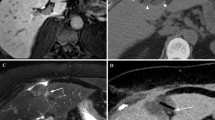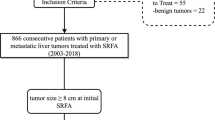Abstract
Background: Radiofrequency ablation (RFA) is increasingly used for the local destruction of unresectable hepatic malignancies. There is little information on its optimal approach or potential complications.
Methods: Since late 1997, we have undertaken 91 RFA procedures to ablate 231 unresectable primary or metastatic liver tumors in 84 patients. RFA was performed via celiotomy (n=39), laparoscopy (n=27), or a percutaneous approach (n=25). Patients were followed with spiral computed tomographic (CT) scans at 1 to 2 weeks postprocedure and then every 3 months for 2 years.
Results: Intraoperative ultrasound (IOUS) detected intrahepatic disease not evident on the preoperative scans of 25 of 66 patients (38%) undergoing RFA via celiotomy or laparoscopy. In 38 of 84 patients (45%), RFA was combined with resection or cryosurgical ablation (CSA), or both. RFA was used to treat an average of 2.8 lesions per patient, and the median size of treated lesions was 2 cm (range, 0.3–9 cm). The average hospital stay was 3.6 days overall (1.8 days for percutaneous and laparoscopic cases). Ten patients underwent a second RFA procedure (sequential ablations) and, in one case, a third RFA procedure for large (one patient), progressive (seven patients), and/or recurrent (three patients) lesions. Seven (8%) patients had complications: one skin burn; one postoperative hemorrhage; two simple hepatic abscesses; one hepatic abscess associated with diaphragmatic heat necrosis following sequential percutaneous ablations of a large lesion; one postoperative myocardial infarction; and one liver failure. There were three deaths, one (1%) of which was directly related to the RFA procedure. Three of the complications, including one RFA-related death, occurred after percutaneous RFA. At a median follow-up of 9 months (range, 1–27 months), 15 patients (18%) had recurrences at an RFA site, and 36 patients (43%) remained clinically free of disease.
Conclusions: Celiotomy or laparoscopic approaches are preferred for RFA because they allow IOUS, which may demonstrate occult hepatic disease. Operative RFA also allows concomitant resection, CSA, or placement of a hepatic artery infusion pump, and isolation of the liver from adjacent organs. Percutaneous RFA should be reserved for patients at high risk for anesthesia, those with recurrent or progressive lesions, and those with smaller lesions sufficiently isolated from adjacent organs. Complications may be minimized when these approaches are applied selectively.
Similar content being viewed by others
References
Cady B, Jenkins RL, Steele GD Jr, et al. Surgical margin in hepatic resection for colorectal metastasis: a critical and improvable determinant of outcome.Ann Surg 1998;227:566–71.
Bilchik AJ, Sarantou T, Wardlaw JC, Ramming KP. Cryosurgery causes a profound reduction in tumor markers in hepatoma and noncolorectal hepatic metastases.Am Surg 1997;63:796–800.
Bilchik AJ, Sarantou T, Foshag LJ, Giuliano AE, Ramming KP. Cryosurgical palliation of metastatic neuroendocrine tumors resistant to conventional therapy.Surgery 1997;122:1040–7.
Pearson AS, Izzo F, Fleming RY, et al. Intraoperative radiofrequency ablation or cryoablation for hepatic malignancies.Am J Surg 1999;178:592–9.
Bilchik AJ, Wood TF, Allegra D, et al. Cryosurgery and radiofrequency ablation of unresectable hepatic malignancies: a proposed algorithm.Arch Surg 2000; 135:657–62.
Ravikumar TS, Kane R, Cady B, Jenkins R, Clouse M, Steele G Jr. A 5-year study of cryosurgery in the treatment of liver tumors.Arch Surg 1991;126:1520–3.
Seifert JK, Morris DL. World survey on the complications of hepatic and prostate cryotherapy.World J Surg 1999;23:109–13.
Sarantou T, Bilchik A, Ramming KP. Complications of hepatic cryosurgery.Semin Surg Oncol 1998;14:156–62.
Rossi S, Di Stasi M, Buscarini E, et al. Percutaneous radiofrequency interstitial thermal ablation in the treatment of small hepatocellular carcinoma.Cancer J Sci Am 1995;1:73.
Siperstein AE, Rogers SJ, Hansen PD, Gitomirsky A. Laparoscopic thermal ablation of hepatic neuroendocrine tumor metastases.Surgery 1997;122:1147–54.
Solbiati L, Ierace T, Goldberg SN, et al. Percutaneous US-guided radio-frequency tissue ablation of liver metastases: treatment and follow-up in 16 patients.Radiology 1997;202:195–203.
Rose DM, Allegra DP, Bostick PJ, Foshag LJ, Bilchik AJ. Radiofrequency ablation: a novel primary and adjunctive ablative technique for hepatic malignancies.Am Surg 1999;65:1009–14.
Bilchik AJ, Rose DM, Allegra DP, Bostick PJ, Hsueh E, Morton DL. Radiofrequency ablation: a minimally invasive technique with multiple applications.Cancer J Sci Am 1999;5:356–61.
Curley SA, Izzo F, Delrio P, et al. Radiofrequency ablation of unresectable primary and metastatic hepatic malignancies: results in 123 patients.Ann Surg 1999;230:1–8.
Buscarini L, Rossi S, Fornari F, Di Stasi M, Buscarini E. Laparoscopic ablation of liver adenoma by radiofrequency electrocautery.Gastrointest Endosc 1995;41:68–70.
Rossi S, Di Stasi M, Buscarini E, et al. Percutaneous RF interstitial thermal ablation in the treatment of hepatic cancer.AJR Am J Roentgenol 1996;167:759–68.
Elias D, Debaere T, Muttillo I, Cavalcanti A, Coyle C, Roche A. Intraoperative use of radiofrequency treatment allows an increase in the rate of curative liver resection.J Surg Oncol 1998;67:190–1.
Jiao LR, Hansen PD, Havlik R, Mitry RR, Pignatelli M, Habib N. Clinical short-term results of radiofrequency ablation in primary and secondary liver tumors.Am J Surg 1999;177:303–6.
Scudamore CH, Lee SI, Patterson EJ, et al. Radiofrequency ablation followed by resection of malignant liver tumors.Am J Surg 1999;177:411–17.
Fong Y, Sun RL, Jarnagin W, Blumgart LH. An analysis of 412 cases of hepatocellular carcinoma at a Western center.Ann Surg 1999;229:790–9.
Fong Y, Fortner J, Sun RL, Brennan MF, Blumgart LH. Clinical score for predicting recurrence after hepatic resection for metastatic colorectal cancer: analysis of 1001 consecutive cases.Ann Surg 1999;230:309–18.
Patterson EJ, Scudamore CH, Owen DA, Nagy AG, Buczkowski AK. Radiofrequency ablation of porcine liver in vivo: effects of blood flow and treatment time on lesion size.Ann Surg 1998;227:559–65.
Kemeny N, Huang Y, Cohen AM, et al. Hepatic arterial infusion of chemotherapy after resection of hepatic metastases from colorectal cancer.N Engl J Med 1999;341:2039–48.
Author information
Authors and Affiliations
Corresponding author
Rights and permissions
About this article
Cite this article
Wood, T.F., Rose, D.M., Chung, M. et al. Radiofrequency ablation of 231 unresectable hepatic tumors: Indications, limitations, and complications. Ann Surg Oncol 7, 593–600 (2000). https://doi.org/10.1007/BF02725339
Received:
Accepted:
Issue Date:
DOI: https://doi.org/10.1007/BF02725339




